Severe Fire Danger Index: A Forecastable Metric to Inform Firefighter and Community Wildfire Risk Management
Abstract
1. Introduction
2. Materials and Methods
2.1. Gridded Fire Danger Climatology
2.1.1. ERC and BI
2.1.2. ERC and BI Percentiles
2.2. Severe Fire Danger Index
2.3. Associations with New and Ongoing Fire Activity
2.4. Evaluations
2.5. Forecasting the Severe Fire Danger Index
2.6. Comparing SFDI to Firefighter Entrapment and Fatality Events from 1979–2017
3. Results
3.1. ERC, BI and Their Percentiles
3.2. SFDI
3.3. Operational SFDI Forecasts
3.3.1. Significant California Wildfires in 2017 and 2018
3.3.2. CONUS-Wide Associations with Observed Fire Activity
3.4. Fire Danger on Days at Entrapment Locations
4. Discussion
5. Conclusions
Author Contributions
Funding
Acknowledgments
Conflicts of Interest
Appendix A
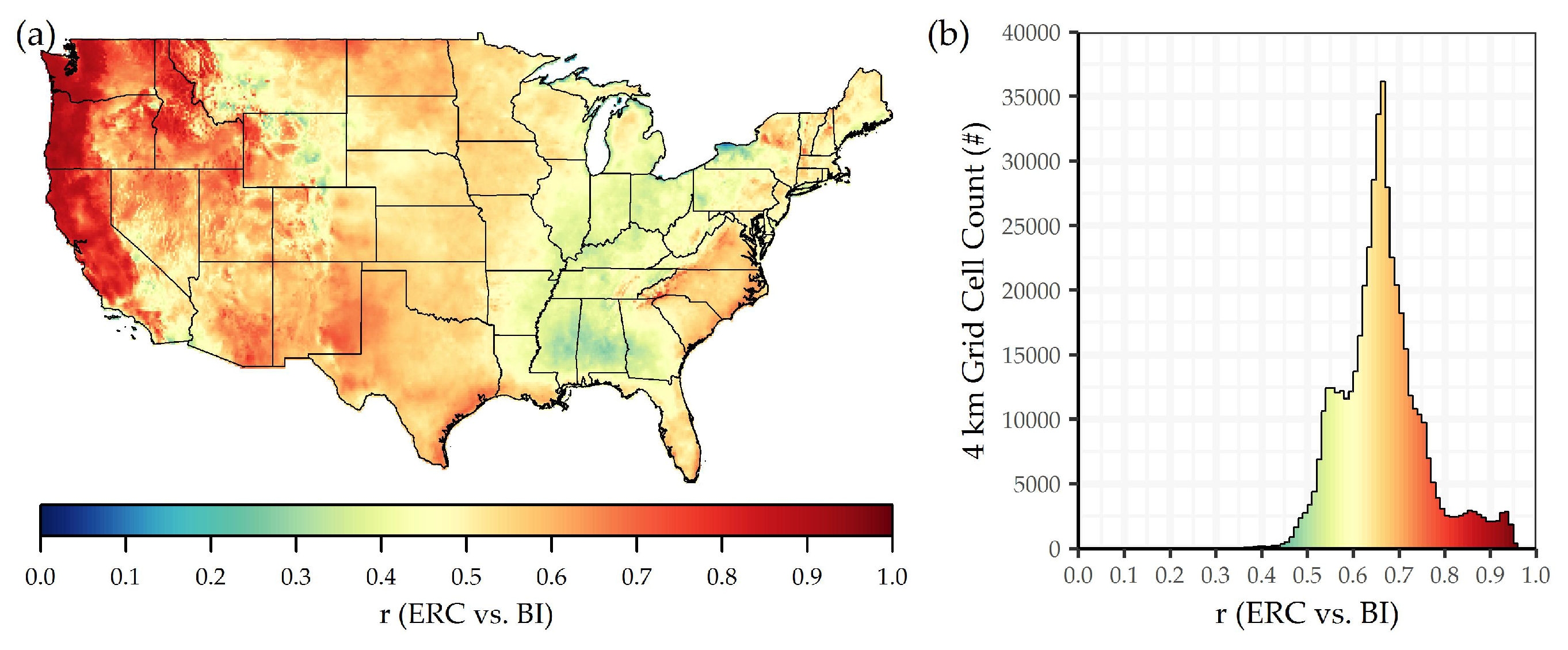
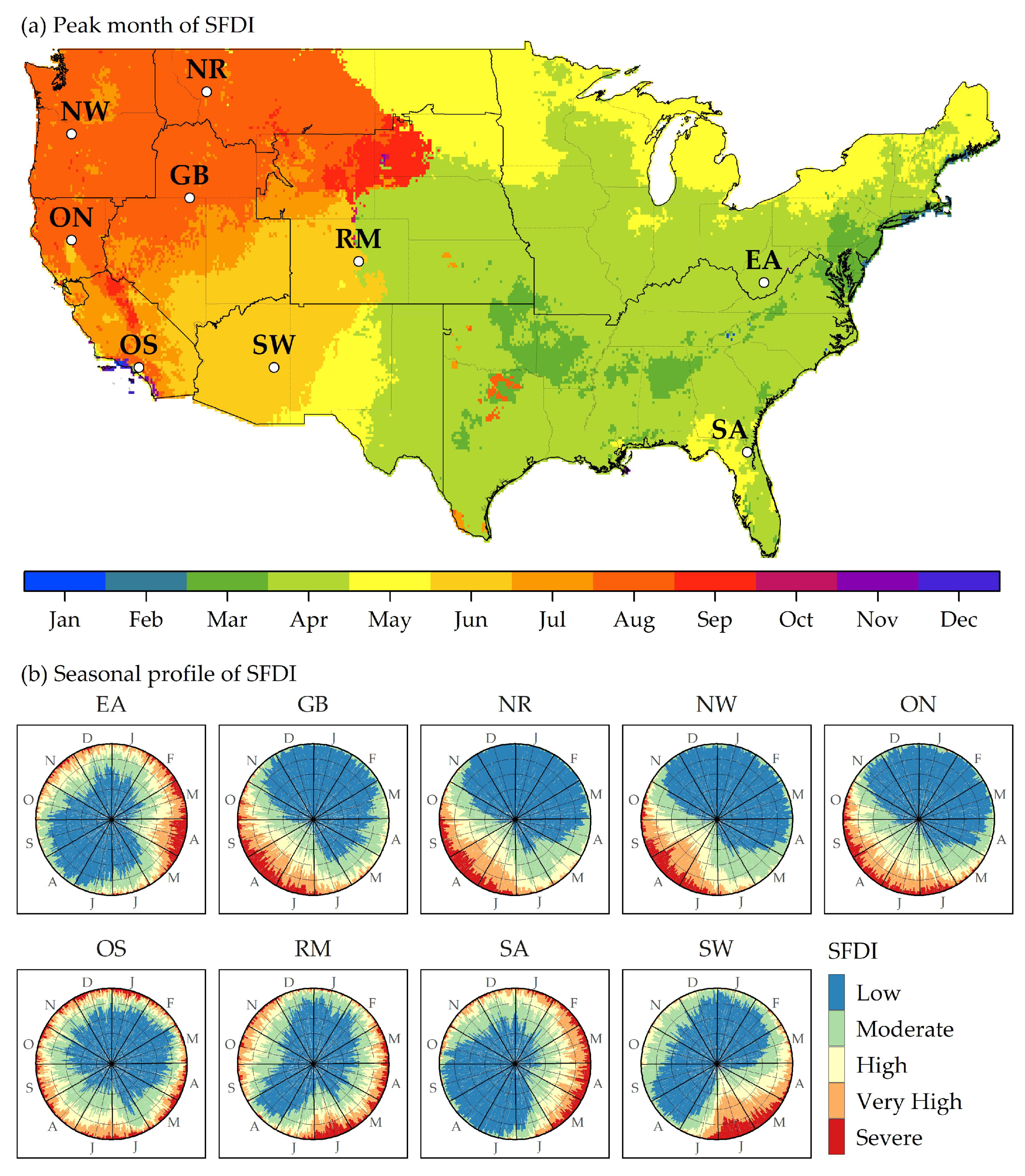
References
- Bowman, D.M.J.S.; Balch, J.K.; Artaxo, P.; Bond, W.J.; Carlson, J.M.; Cochrane, M.A.; D’Antonio, C.M.; DeFries, R.S.; Doyle, J.C.; Harrison, S.P.; et al. Fire in the Earth System. Science 2009, 324, 481–484. [Google Scholar] [CrossRef] [PubMed]
- Alexander, M.E.; Mutch, R.W.; Davis, K.M.; Bucks, C.M. Wildland fires: Dangers and survival. In Wilderness Medicine, 7th ed.; Auerback, P.S., Ed.; Elsevier, Mosby: Philadelphia, PA, USA, 2017; pp. 276–318. [Google Scholar]
- Jolly, W.M.; Cochrane, M.A.; Freeborn, P.H.; Holden, Z.A.; Brown, T.J.; Williamson, G.J.; Bowman, D.M.J.S. Climate-induced variations in global wildfire danger from 1979 to 2013. Nat. Commun. 2015, 6, 7537. [Google Scholar] [CrossRef] [PubMed]
- Westerling, A.L.; Hidalgo, H.G.; Cayan, D.R.; Swetnam, T.W. Warming and earlier spring increase western US forest wildfire activity. Science 2006, 313, 940–943. [Google Scholar] [CrossRef]
- Littell, J.S.; McKenzie, D.; Peterson, D.L.; Westerling, A.L. Climate and wildfire area burned in western U. S. ecoprovinces, 1916–2003. Ecol. Appl. 2009, 19, 1003–1021. [Google Scholar] [CrossRef]
- Dennison, P.E.; Brewer, S.C.; Arnold, J.D.; Moritz, M.A. Large wildfire trends in the western United States, 1984–2011. Geophys. Res. Lett. 2014, 41, 2928–2933. [Google Scholar] [CrossRef]
- Abatzoglou, J.T.; Williams, A.P. Impact of anthropogenic climate change on wildfire across western US forests. Proc. Natl. Acad. Sci. USA 2016, 113, 11770–11775. [Google Scholar] [CrossRef] [PubMed]
- Westerling, A.L. Increasing western US forest wildfire activity: sensitivity to changes in the timing of spring. Philos. Trans. R. Soc. -Biol. Sci. 2016, 371. [Google Scholar] [CrossRef] [PubMed]
- Kitzberger, T.; Falk, D.A.; Westerling, A.L.; Swetnam, T.W. Direct and indirect climate controls predict heterogeneous early-mid 21st century wildfire burned area across western and boreal North America. PLoS ONE 2017, 12, e0188486. [Google Scholar] [CrossRef]
- Holden, Z.A.; Swanson, A.; Luce, C.H.; Jolly, W.M.; Maneta, M.; Oyler, J.W.; Warren, D.A.; Parsons, R.; Affleck, D. Decreasing fire season precipitation increased recent western US forest wildfire activity. Proc. Natl. Acad. Sci. USA 2018, 115, E8349–E8357. [Google Scholar] [CrossRef]
- Britton, C.; Lynch, C.F.; Torner, J.; Peek-Asa, C. Fire characteristics associated with firefighter injury on large federal wildland fires. Ann. Epidemiol. 2013, 23, 37–42. [Google Scholar] [CrossRef]
- Radeloff, V.C.; Hammer, R.B.; Stewart, S.I.; Fried, J.S.; Holcomb, S.S.; McKeefry, J.F. The wildland–urban interface in the United States. Ecol. Appl. 2005, 15, 799–805. [Google Scholar] [CrossRef]
- Radeloff, V.C.; Helmers, D.P.; Kramer, H.A.; Mockrin, M.H.; Alexandre, P.M.; Bar-Massada, A.; Butsic, V.; Hawbaker, T.J.; Martinuzzi, S.; Syphard, A.D.; et al. Rapid growth of the US wildland-urban interface raises wildfire risk. Proc. Natl. Acad. Sci. USA 2018, 115, 3314–3319. [Google Scholar] [CrossRef] [PubMed]
- Diffenbaugh, N.S.; Swain, D.L.; Touma, D. Anthropogenic warming has increased drought risk in California. Proc. Natl. Acad. Sci. USA 2015, 112, 3931–3936. [Google Scholar] [CrossRef] [PubMed]
- California Department of Forestry and Fire Protection. Top 20 Most Destructive California Wildfires. 2019. Available online: http://www.fire.ca.gov/communications/downloads/fact_sheets/Top20_Destruction.pdf (accessed on 28 January 2019).
- California Department of Forestry and Fire Protection. Top 20 Largest California Wildfires. 2019. Available online: http://www.fire.ca.gov/communications/downloads/fact_sheets/Top20_Acres.pdf (accessed on 28 January 2019).
- California Department of Forestry and Fire Protection. Top 20 Deadliest California Wildfires. 2018. Available online: http://calfire.ca.gov/communications/downloads/fact_sheets/Top20_Deadliest.pdf (accessed on 28 January 2019).
- Parisien, M.A.; Miller, C.; Parks, S.A.; DeLancey, E.R.; Robinne, F.N.; Flannigan, M.D. The spatially varying influence of humans on fire probability in North America. Environ. Res. Lett. 2016, 11, 075005. [Google Scholar] [CrossRef]
- Bistinas, I.; Oom, D.; Sá, A.C.L.; Harrison, S.P.; Prentice, I.C.; Pereira, J.M.C. Relationships between human population density and burned area at continental and global scales. PLoS ONE 2013, 8, e81188. [Google Scholar] [CrossRef] [PubMed]
- Bradshaw, L.S.; Deeming, J.E.; Burgan, R.E.; Cohen, J.D. The 1978 National Fire-Danger Rating System: Technical Documentation; General Technical Report INT-169; U.S. Department of Agriculture, Forest Service, Intermountain Forest and Range Experiment Station: Ogden, UT, USA, 1984; p. 44.
- Noble, I.; Gill, A.; Bary, G. McArthur’s fire-danger meters expressed as equations. Aust. J. Ecol. 1980, 5, 201–203. [Google Scholar] [CrossRef]
- Stocks, B.J.; Lynham, T.; Lawson, B.; Alexander, M.; Wagner, C.V.; McAlpine, R.; Dube, D. Canadian forest fire danger rating system: An overview. For. Chron. 1989, 65, 450–457. [Google Scholar] [CrossRef]
- Schlobohm, P.; Brain, J. Gaining an Understanding of the National Fire Danger Rating System; PMS 932; National Wildfire Coordinating Group, Fire Danger Working Team: Boise, ID, USA, 2002; p. 72. [Google Scholar]
- Glahn, H.R.; Ruth, D.P. The new digital forecast database of the National Weather Service. Bull. Am. Meteorol. Soc. 2003, 84, 195–202. [Google Scholar] [CrossRef]
- Abatzoglou, J.T. Development of gridded surface meteorological data for ecological applications and modelling. Int. J. Climatol. 2013, 33, 121–131. [Google Scholar] [CrossRef]
- Nauslar, N.; Abatzoglou, J.; Marsh, P. The 2017 North Bay and Southern California fires: A case study. Fire 2018, 1, 18. [Google Scholar] [CrossRef]
- Mesinger, F.; DiMego, G.; Kalnay, E.; Mitchell, K.; Shafran, P.C.; Ebisuzaki, W.; Jovic, D.; Woollen, J.; Rogers, E.; Berbery, E.H.; et al. North American regional reanalysis. Bull. Am. Meteorol. Soc. 2006, 87, 343–360. [Google Scholar] [CrossRef]
- Andrews, P.L.; Loftsgaarden, D.O.; Bradshaw, L.S. Evaluation of fire danger rating indexes using logistic regression and percentile analysis. Int. J. Wildland Fire 2003, 12, 213–226. [Google Scholar] [CrossRef]
- Cohen, J.D.; Deeming, J.E. The National Fire-Danger Rating System: Basic Equations; General Technical Report PSW-82; U.S. Department of Agriculture, Forest Service, Pacific Southwest Forest and Range Experiment Station: Berkeley, CA, USA, 1985; p. 16.
- National Wildfire Coordinating Group (NWCG). Incident Response Pocket Guide. 2018. Available online: https://www.nwcg.gov/publications/461 (accessed on 15 May 2019).
- Jolly, W.M.; Freeborn, P.H. Towards improving wildland firefighter situational awareness through daily fire behaviour risk assessments in the US Northern Rockies and Northern Great Basin. Int. J. Wildland Fire 2017, 26, 574–586. [Google Scholar] [CrossRef]
- National Wildfire Coordinating Group (NWCG). Interagency Standards for Fire and Fire Aviation Operations 2019; National Interagency Fire Center, Great Basin Cache Supply Office: Boise, ID, USA, 2019. [Google Scholar]
- Finney, M.A.; Grenfell, I.C.; McHugh, C.W.; Seli, R.C.; Trethewey, D.; Stratton, R.D.; Brittain, S. A method for ensemble wildland fire simulation. Environ. Model. Assess. 2011, 16, 153–167. [Google Scholar] [CrossRef]
- Short, K.C. A spatial database of wildfires in the United States, 1992-2011. Earth Syst. Sci. Data 2014, 6, 1–27. [Google Scholar] [CrossRef]
- Giglio, L.; Schroeder, W.; Justice, C.O. The collection 6 MODIS active fire detection algorithm and fire products. Remote. Sens. Environ. 2016, 178, 31–41. [Google Scholar] [CrossRef]
- Eidenshink, J.; Schwind, B.; Brewer, K.; Zhu, Z.; Quayle, B.; Howard, S. A Project for Monitoring Trends in Burn Severity. Fire Ecol. 2007, 3. [Google Scholar] [CrossRef]
- Malamud, B.D.; Millington, J.D.A.; Perry, G.L.W. Characterizing wildfire regimes in the United States. Proc. Natl. Acad. Sci. USA 2005, 102, 4694–4699. [Google Scholar] [CrossRef]
- Kumar, S.S.; Roy, D.P.; Boschetti, L.; Kremens, R. Exploiting the power law distribution properties of satellite fire radiative power retrievals: A method to estimate fire radiative energy and biomass burned from sparse satellite observations. J. Geophys. Res. Atmos. 2011, 116, 17. [Google Scholar] [CrossRef]
- Rijal, B. Quantile regression: an alternative approach to modelling forest area burned by individual fires. Int. J. Wildland Fire 2018, 27, 538–549. [Google Scholar] [CrossRef]
- Mees, R.; Chase, R. Relating Burning Index to Wildfire Workload Over Broad Geographic Areas. Int. J. Wildland Fire 1991, 1, 235–238. [Google Scholar] [CrossRef]
- Koenker, R. Quantile Regression in R: A Vignette. In Quantile Regression; Econometric Society Monographs, Cambridge University Press: Cambridge, UK, 2005; pp. 295–316. [Google Scholar] [CrossRef]
- Akaike, H. Information theory and an extension of the maximum likelihood principle. In Second International Symposium on Information Theory; Petrov, B.N., Csaki, B.F., Eds.; Akadémiai Kiadó: Budapest, Hungary, 1973; pp. 267–281. [Google Scholar]
- Jolly, M. Seven day fire danger forecasts from the National Digital Forecast Database. In Eighth Symposium on Fire and Forest Meteorology; American Meteorological Society: Kalispell, MT, USA, October 2009; pp. 13–15. [Google Scholar]
- Jolly, W.M.; Andrews, P.L.; Bradshaw, L.S. The Wildland Fire Assessment System (WFAS): A web-based resource for decision support. In EastFire Conference Proceedings; George Mason University: Fairfax, VA, USA, May 2005. [Google Scholar]
- Schroeder, W.; Oliva, P.; Giglio, L.; Csiszar, I.A. The New VIIRS 375m active fire detection data product: Algorithm description and initial assessment. Remote Sens. Environ. 2014, 143, 85–96. [Google Scholar] [CrossRef]
- Geospatial Multi-Agency Coordinating Group (GeoMAC). Fire Perimeter Dataset. 2019. Available online: https://rmgsc.cr.usgs.gov/outgoing/GeoMAC/ (accessed on 15 May 2019).
- Finney, M.; Grenfell, I.C.; McHugh, C.W. Modeling Containment of Large Wildfires Using Generalized Linear Mixed-Model Analysis. For. Sci. 2009, 55, 249–255. [Google Scholar] [CrossRef]
- Plucinski, M.P. Fighting flames and forging firelines: wildfire suppression effectiveness at the fire edge. Curr. For. Rep. 2019, 5, 1–19. [Google Scholar] [CrossRef]
- Page, W.G.; Freeborn, P.H.; Butler, B.W.; Jolly, W.M. A review of US wildland firefighter entrapments: trends, important environmental factors and research needs. Int. J. Wildland Fire 2019. [Google Scholar] [CrossRef]
- Freeborn, P.H.; Cochrane, M.A.; Jolly, W.M. Relationships between fire danger and the daily number and daily growth of active incidents burning in the northern Rocky Mountains, USA. Int. J. Wildland Fire 2015, 24, 900–910. [Google Scholar] [CrossRef]
- Taylor, S.W.; Alexander, M.E. Field Guide to the Canadian Forest Fire Behaviour Prediction (FBP) System, 3rd ed.; Special Report 11; Natural Resources Canada, Canadian Forest Service, Northern Forestry Centre: Edmonton, AB, Canada, 2018; 132p.
- Hobbins, M.T.; Wood, A.; McEvoy, D.J.; Huntington, J.L.; Morton, C.; Anderson, M.; Hain, C. The Evaporative Demand Drought Index. Part I: Linking Drought Evolution to Variations in Evaporative Demand. J. Hydrometeorol. 2016, 17, 1745–1761. [Google Scholar] [CrossRef]
- Srock, A.F.; Charney, J.J.; Potter, B.E.; Goodrick, S.L. The Hot-Dry-Windy Index: A New Fire Weather Index. Atmosphere 2018, 9, 279. [Google Scholar] [CrossRef]
- Wotton, B.M. Interpreting and using outputs from the Canadian Forest Fire Danger Rating System in research applications. Environ. Ecol. Stat. 2009, 16, 107–131. [Google Scholar] [CrossRef]
- Page, W.G.; Wagenbrenner, N.S.; Butler, B.W.; Forthofer, J.M.; Gibson, C. An evaluation of NDFD weather forecasts for wildland fire behavior prediction. Weather. Forecast. 2018, 33, 301–315. [Google Scholar] [CrossRef]
- Wagenbrenner, N.S.; Forthofer, J.M.; Lamb, B.K.; Shannon, K.S.; Butler, B.W. Downscaling surface wind predictions from numerical weather prediction models in complex terrain with WindNinja. Atmos. Chem. Phys. 2016, 16, 5229–5241. [Google Scholar] [CrossRef]
- Holden, Z.A.; Jolly, W.M.; Parsons, R.; Warren, A.; Landguth, E.; Abatzoglou, J. TOPOFIRE: A System for Monitoring Insect and Climate Induced Impacts on Fire Danger in Complex Terrain. Mt. Views 2013, 7, 2–5. [Google Scholar]
- United States Marine Corps. US Marine Corps Operational Risk Management. 2014. Available online: http://www.au.af.mil/au/awc/awcgate/usmc/orm.pdf (accessed on 17 July 2019).
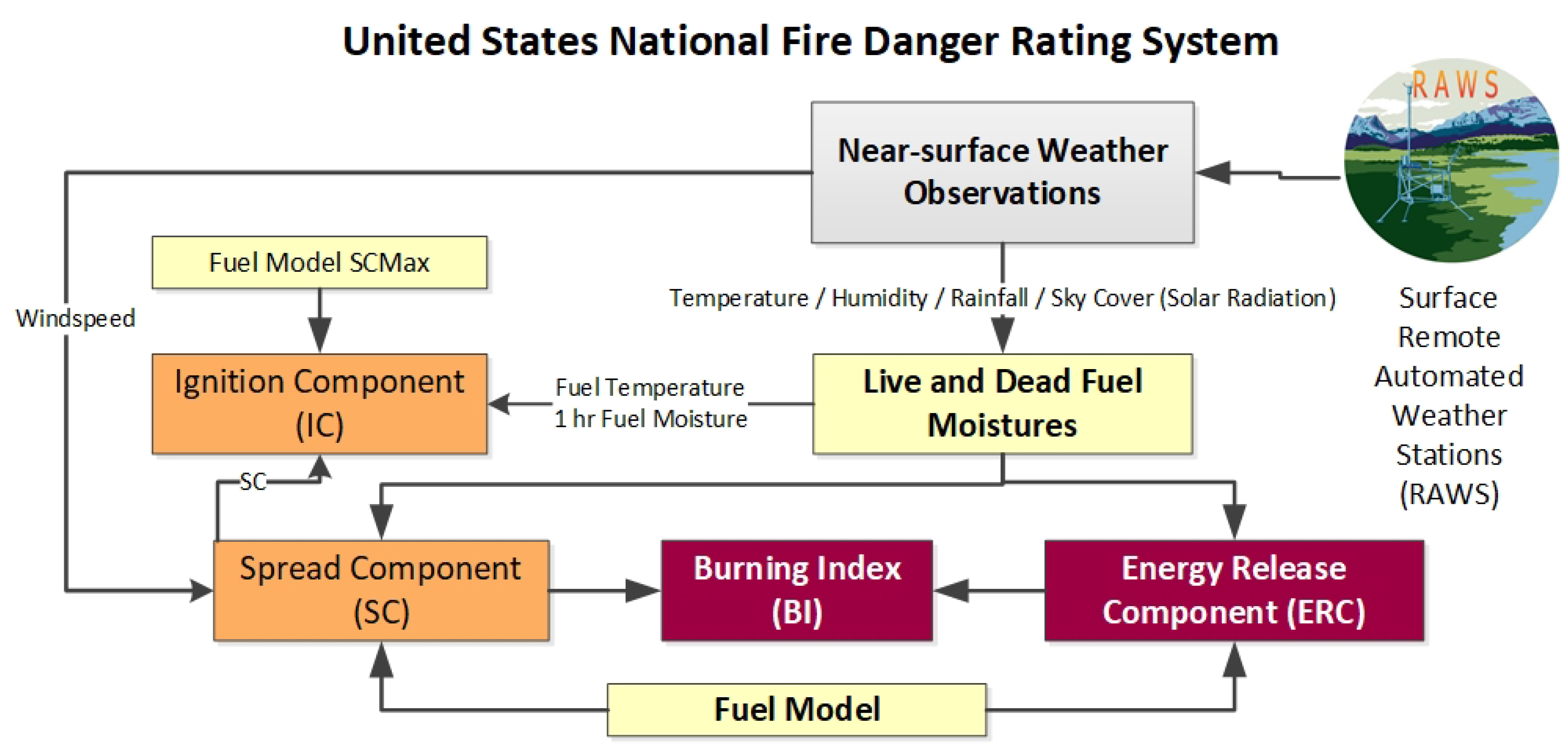
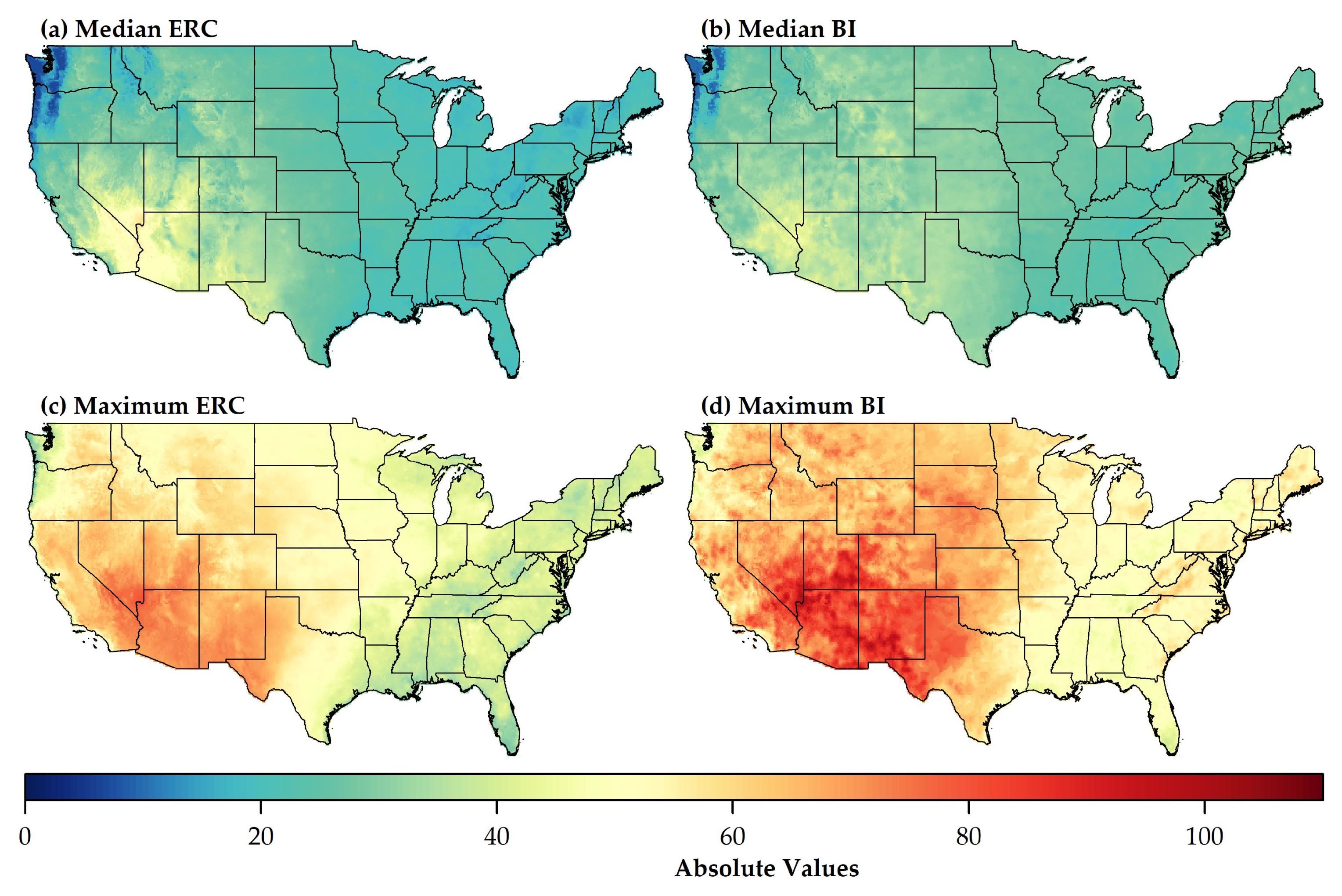
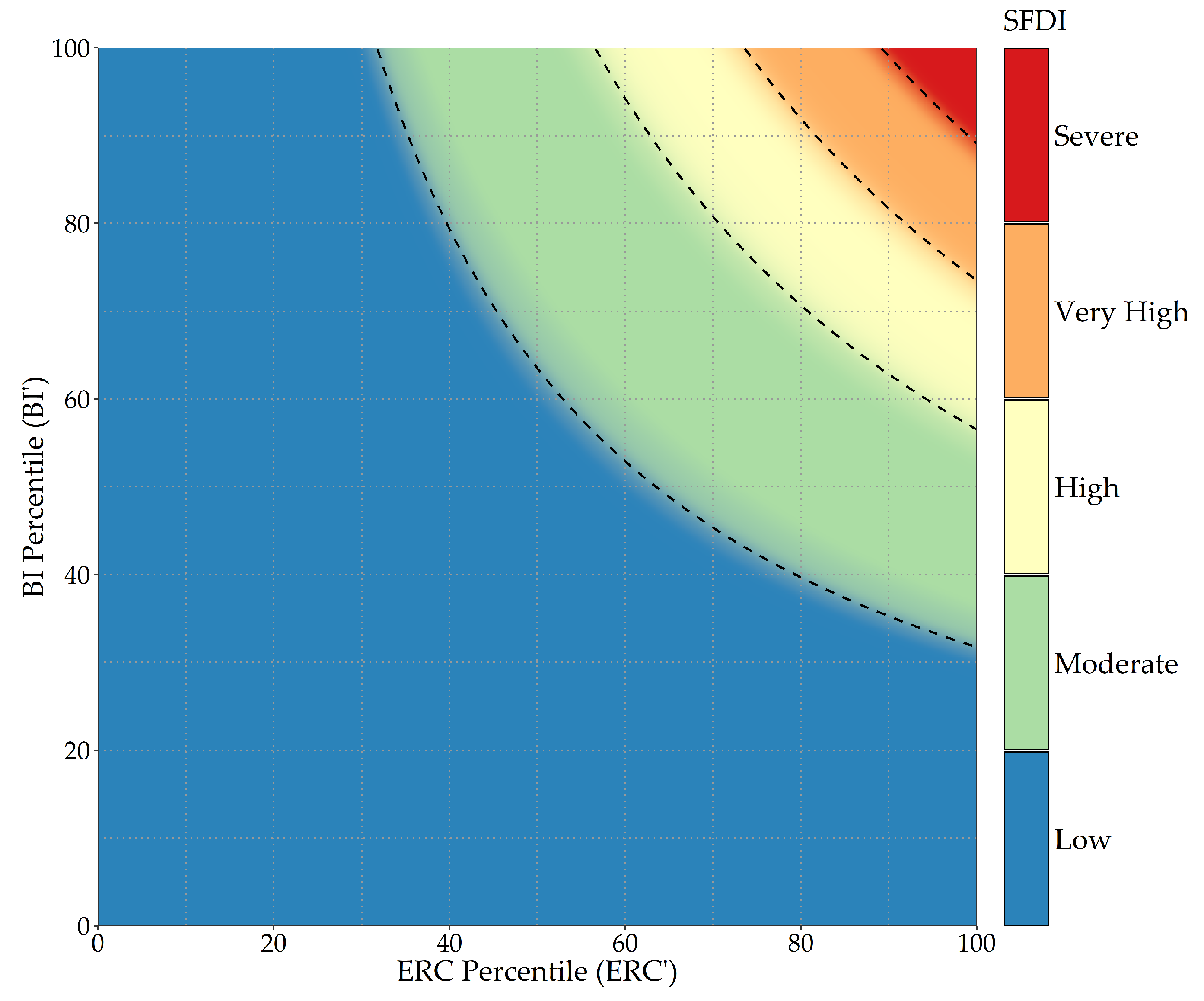
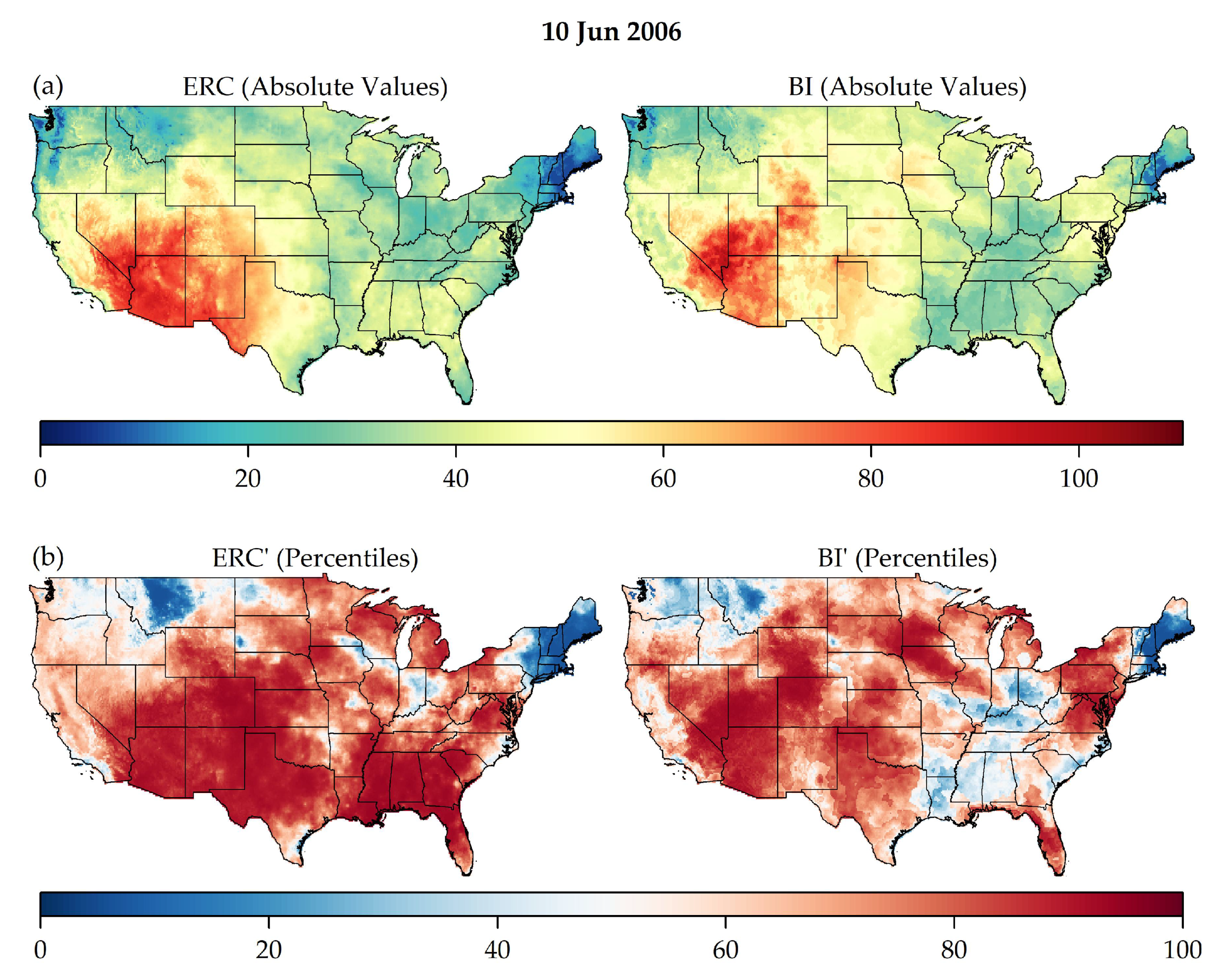
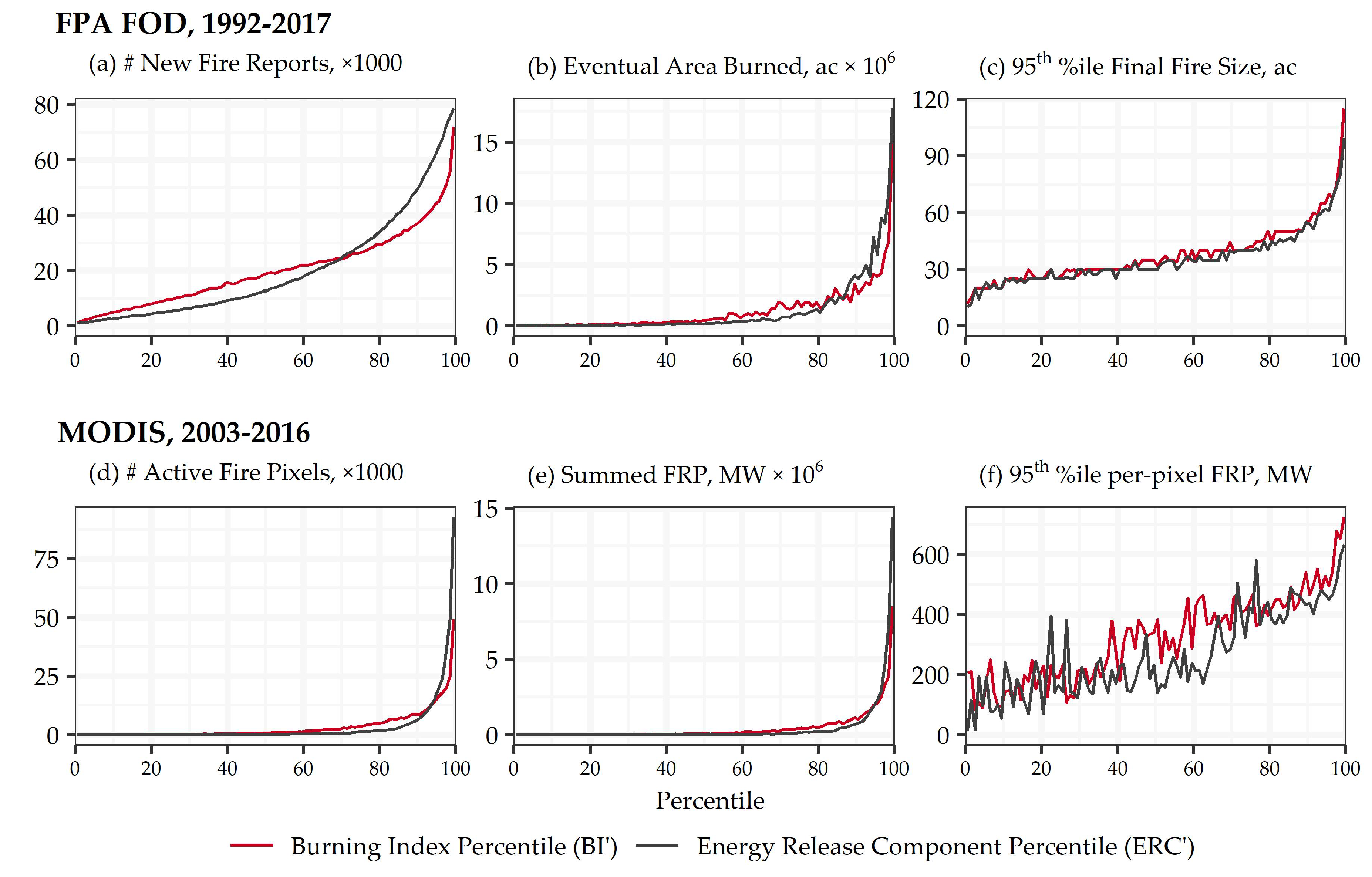
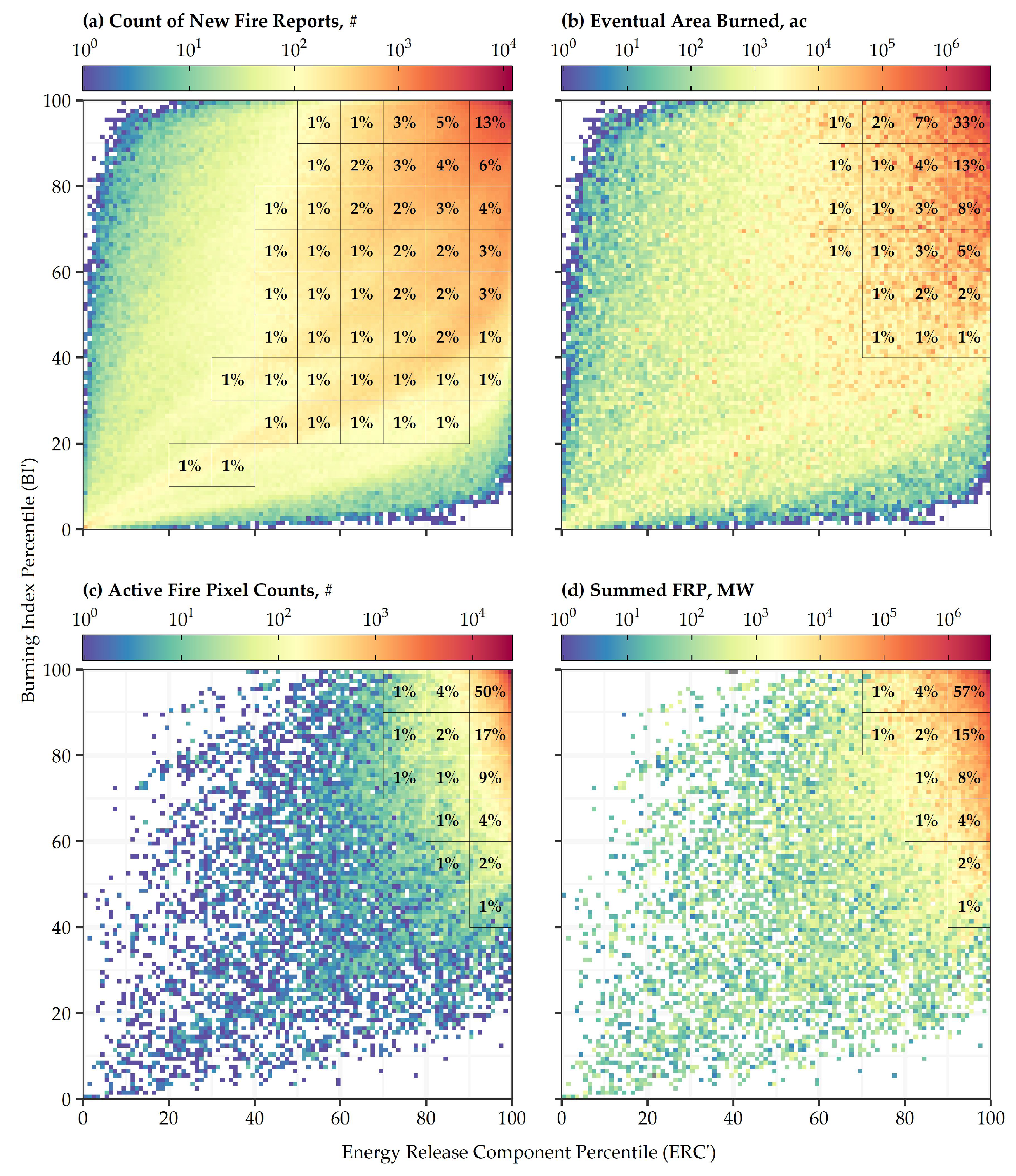
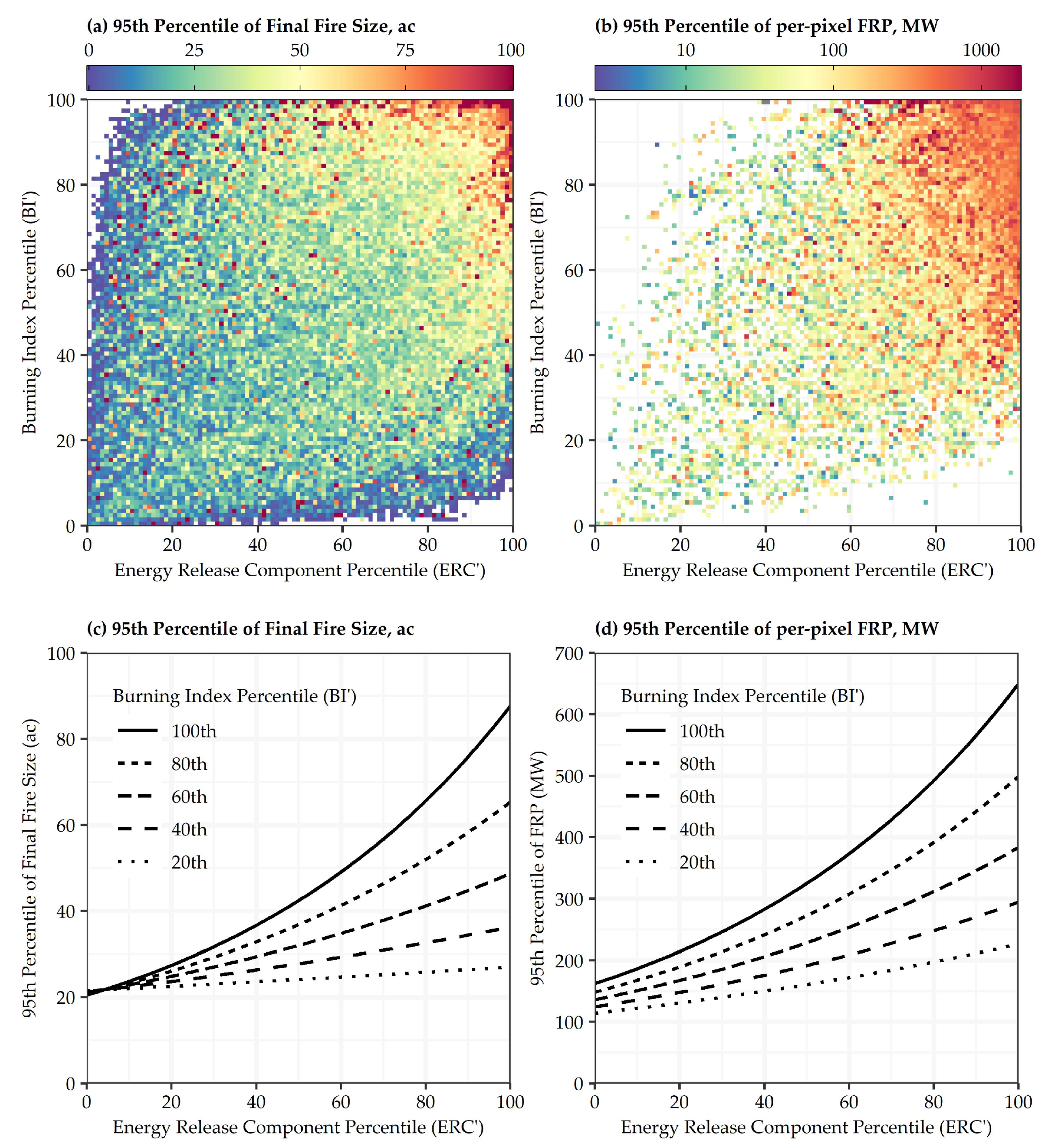
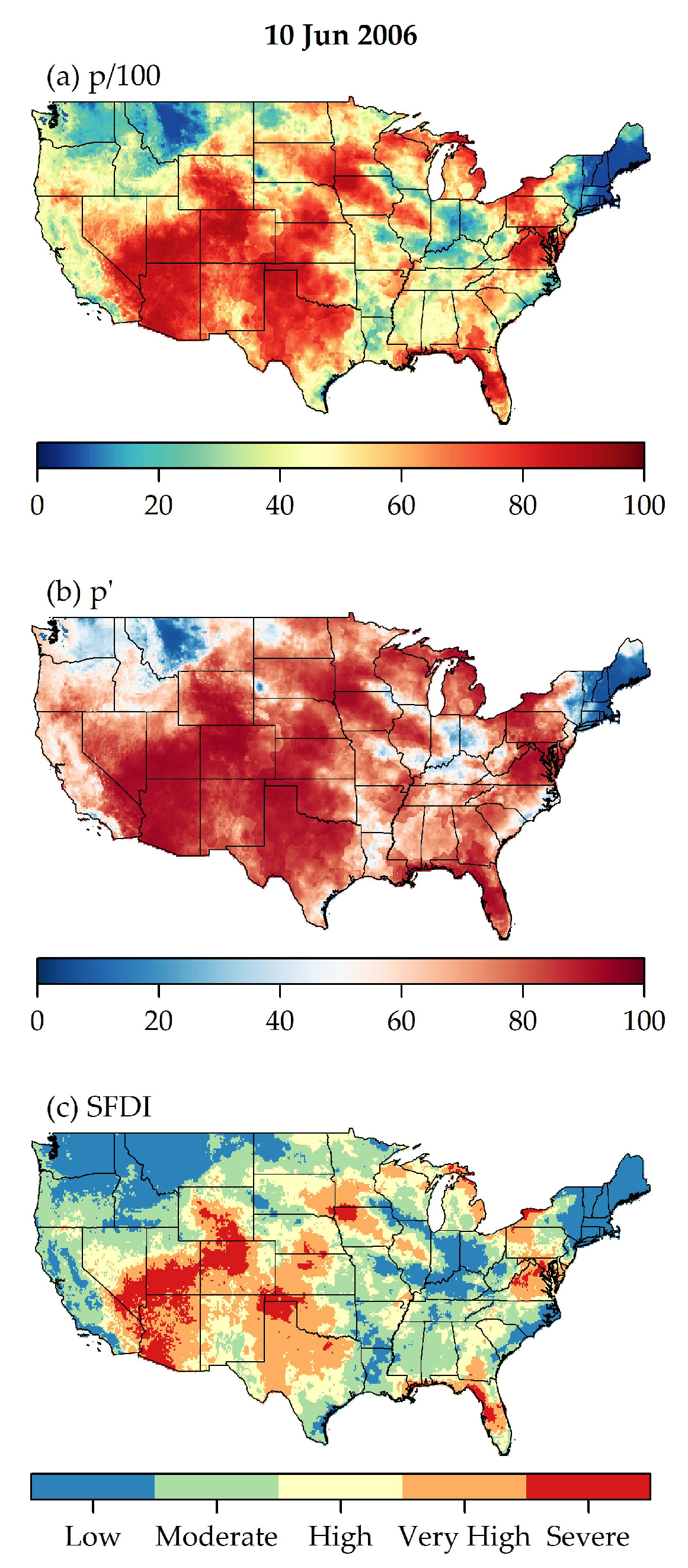
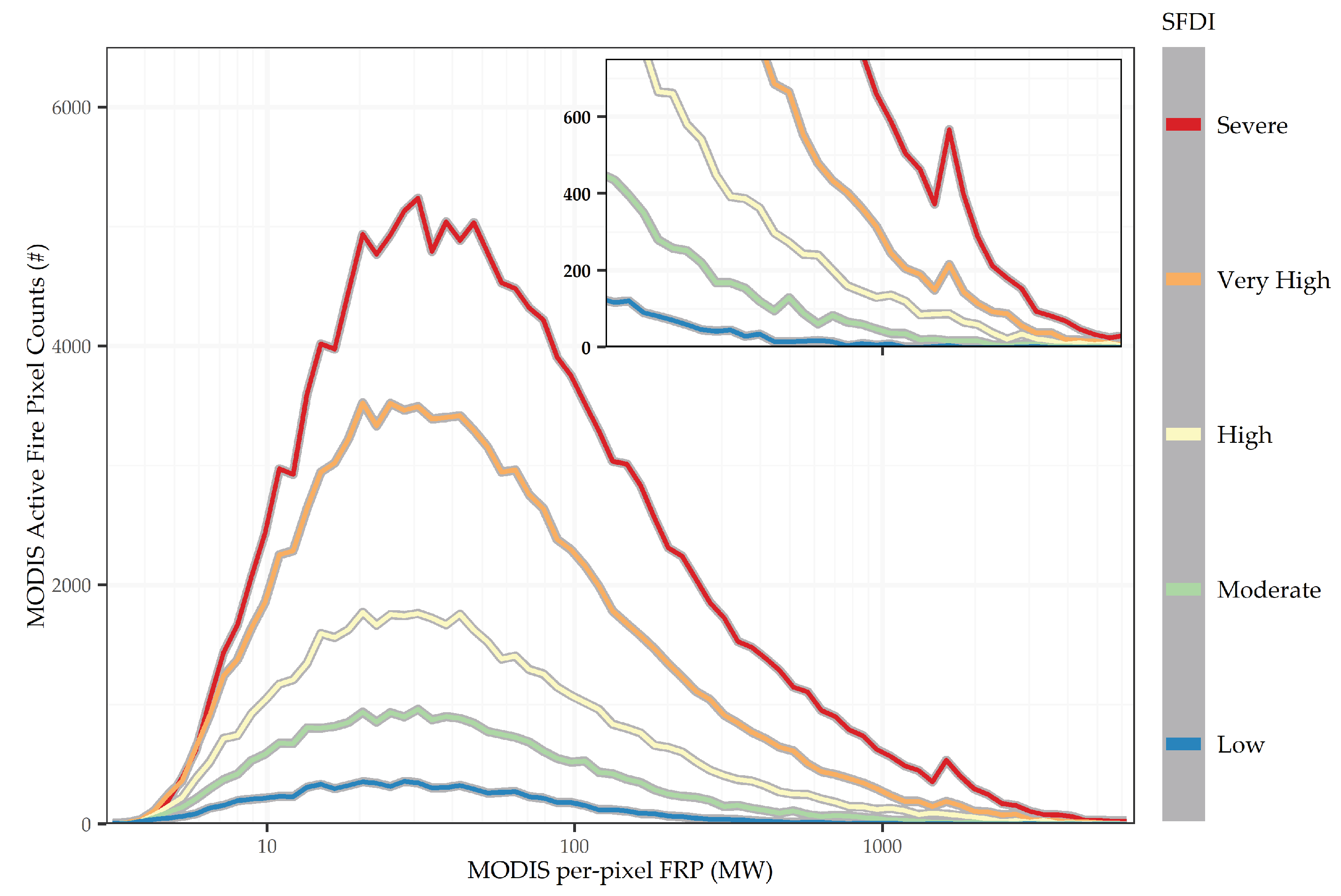
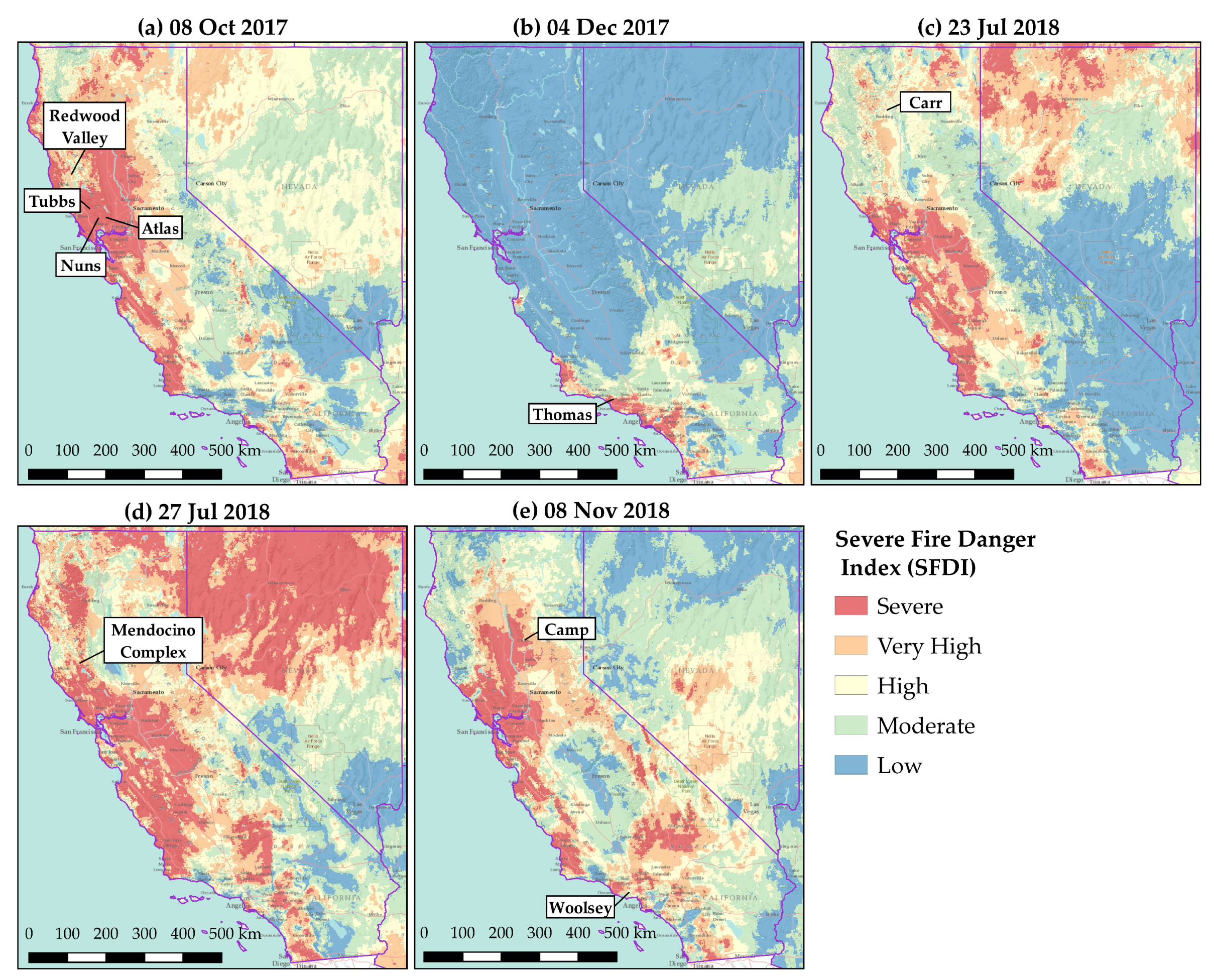

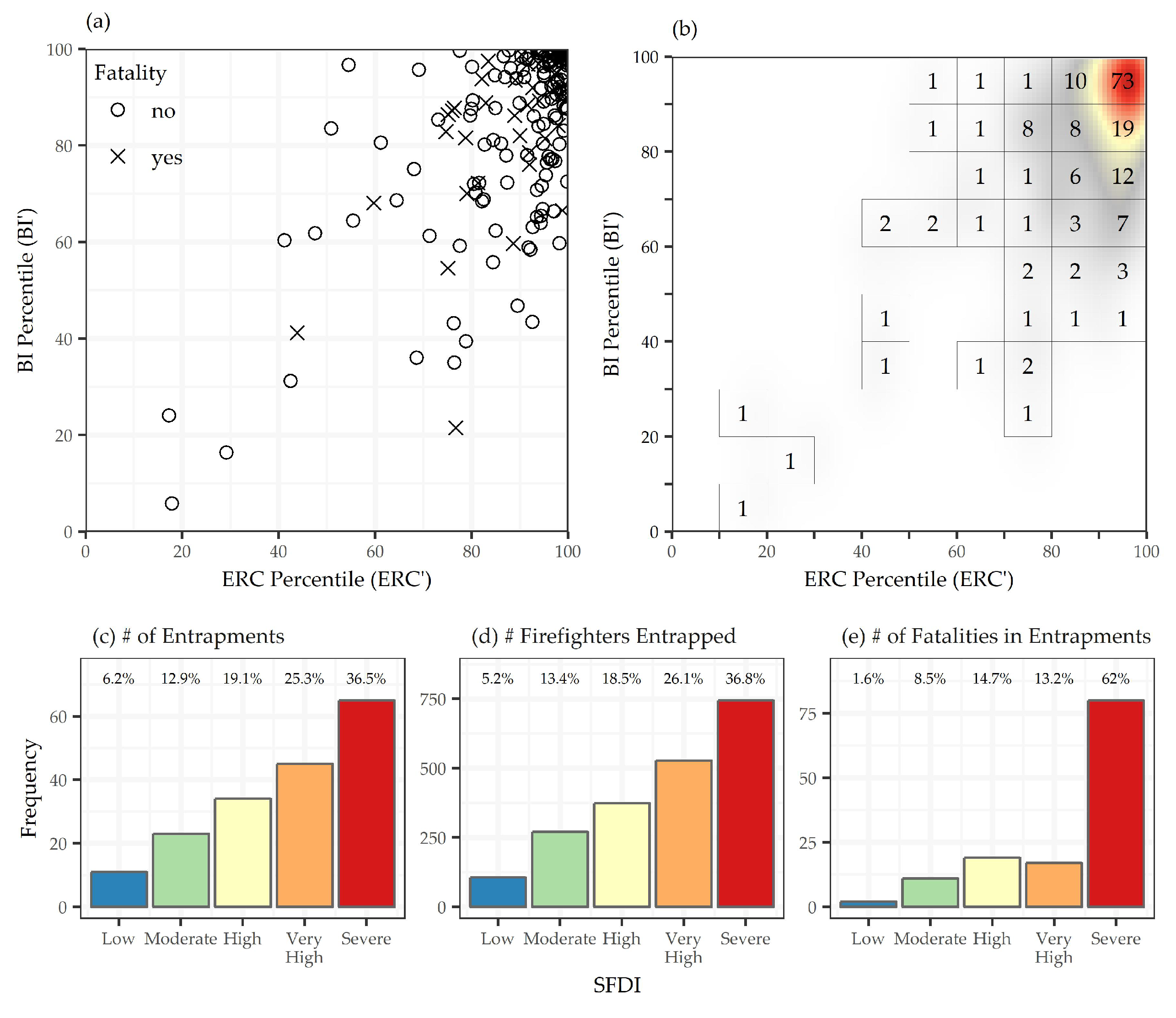
| (a) | (b) | |||||
|---|---|---|---|---|---|---|
| SFDI | Proportion of New Fire Reports | Proportion of Area Burned | 95th %tile of Final Fire Size | Proportion of Active Fire Pixels | Proportion of Summed FRP | 95th %tile of per-Pixel FRP |
| Low | 25.0% | 6.6% | 28 ac | 2.6% | 1.2% | 198.4 MW |
| Moderate | 26.3% | 15.2% | 40 ac | 7.4% | 4.9% | 312.9 MW |
| High | 19.6% | 20.2% | 50 ac | 14.7% | 12.7% | 428.8 MW |
| Very High | 18.4% | 28.1% | 61 ac | 29.7% | 27.2% | 465.7 MW |
| Severe | 10.7% | 29.9% | 95 ac | 45.5% | 54.0% | 639.6 MW |
| SFDI | |||||
|---|---|---|---|---|---|
| Incident (Final Size, ac) | Low | Moderate | High | Very High | Severe |
| Atlas (51,624) | 0.0% | 0.0% | 0.0% | 0.0% | 100.0% |
| Nuns (54,382) | 0.0% | 0.0% | 0.0% | 0.0% | 100.0% |
| Redwood Valley (36,523) | 0.0% | 6.3% | 18.8% | 75.0% | 0.0% |
| Tubbs (36,807) | 0.0% | 0.0% | 0.0% | 0.0% | 100.0% |
| Thomas (281,893) | 0.0% | 10.8% | 10.8% | 16.2% | 62.2% |
| Carr (229,651) | 0.0% | 10.0% | 70.0% | 20.0% | 0.0% |
| Mendocino Complex (459,123) | 0.0% | 0.0% | 15.3% | 46.2% | 38.5% |
| Camp (153,336) | 0.0% | 0.0% | 0.0% | 62.5% | 37.5% |
| Woolsey (96,949) | 0.0% | 40.3% | 31.3% | 25.4% | 3.0% |
| Average | 0.0% | 7.5% | 16.3% | 27.2% | 49.0% |
© 2019 by the authors. Licensee MDPI, Basel, Switzerland. This article is an open access article distributed under the terms and conditions of the Creative Commons Attribution (CC BY) license (http://creativecommons.org/licenses/by/4.0/).
Share and Cite
Jolly, W.M.; Freeborn, P.H.; Page, W.G.; Butler, B.W. Severe Fire Danger Index: A Forecastable Metric to Inform Firefighter and Community Wildfire Risk Management. Fire 2019, 2, 47. https://doi.org/10.3390/fire2030047
Jolly WM, Freeborn PH, Page WG, Butler BW. Severe Fire Danger Index: A Forecastable Metric to Inform Firefighter and Community Wildfire Risk Management. Fire. 2019; 2(3):47. https://doi.org/10.3390/fire2030047
Chicago/Turabian StyleJolly, W. Matt, Patrick H. Freeborn, Wesley G. Page, and Bret W. Butler. 2019. "Severe Fire Danger Index: A Forecastable Metric to Inform Firefighter and Community Wildfire Risk Management" Fire 2, no. 3: 47. https://doi.org/10.3390/fire2030047
APA StyleJolly, W. M., Freeborn, P. H., Page, W. G., & Butler, B. W. (2019). Severe Fire Danger Index: A Forecastable Metric to Inform Firefighter and Community Wildfire Risk Management. Fire, 2(3), 47. https://doi.org/10.3390/fire2030047






